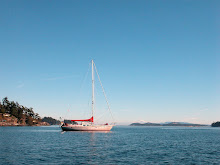More beautiful bergs were casually strewn about as we motored to Sardlog (60' 32N 46' 01W), a community that relocated from the east coast. Once again icebergs made us preform a few extra navigational wiggles to get through the complicated passage between the islands. Frances got Snow Dragon ready to go up to the dock but on closer inspection it turned out not to be suitable, L-shape with dangerous rocks sticking out from both ends. At first we thought the area was too tight to anchor without taking a stern line to shore. The chart showed a shallow area that protruded out but we discovered it was much deeper than charted. In the calm conditions it turned out to be adequate for anchoring on short scope.
Sardloq At Sunset
That night, from the boat, we watched two seals being skinned on the smooth granite boulders in front of Sardloq. The casual way in which it was being done suggested that the meat was for family not commercial use and we were surprised to see the skin thrown into the water after it was removed. Some of the meat was put into clear plastic bags and taken away. Followed by the skins which were retrieved from the water after they had been rinsed and the two rifles that were used during the hunt. But to our surprise the carcasses with a good portion of the meat still intact were leaft on the rocks.
A big part of Inuit-Greenlandic culture is their respect for nature and its resources, following the simple philosophy of not taking more than one needs. Traditionally all of the seal, including the bone would be used. As Greenlanders have become westernized, tradition has become manipulated to make way for a more monetary conscience society. Making the line between necessity and careless use of resources a fine one when profit is derived from the very thing that tradition intended to protect for future generations.
During the mime of the seal hunter we met at the previous community, he expressed thanks to the seal for giving up its life. Another beautiful aspect of the Inuit culture that is slowly fading. When we woke up the following morning and saw three gulls picking at the remains we could not help but wonder if we had witnessed tradition or exploitation. Were the seals mainly killed for their skin and not for food? Was there something wrong with the meat? Our inability to speak Greenlandic made it impossible to ask and the experience left us with more questions than answers.
Gulls Having A Few Bites Of Seal Meat
For more photos please click on Sardloq Album.



No comments:
Post a Comment